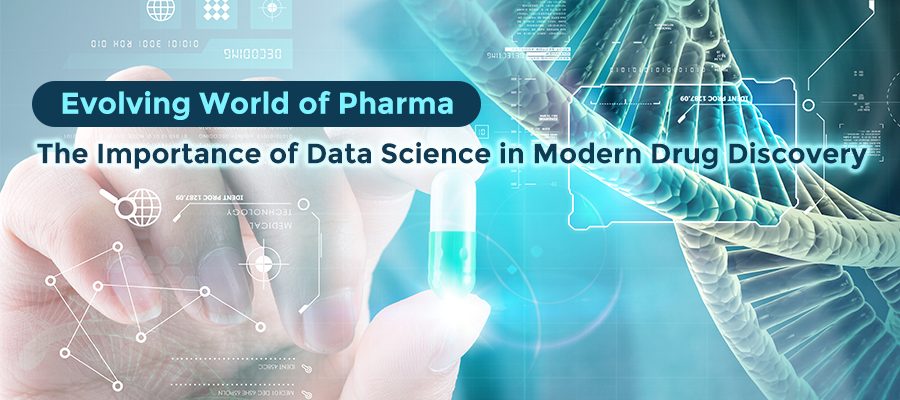Sarah HardingDecember 22, 2020
Tag: data science , modern drug , smart manufacturing
Pressure on pharma to discover and develop new drugs as quickly as possible was already high as companies battled to recoup the costs of long, complex and uncertain drug life cycles. However, the COVID-19 pandemic has created an even more pressing need to develop effective drugs rapidly. This global threat to humanity has reasserted the need for us to discover and develop drugs quickly enough to tackle and floor such threats as they arise.

While historic drug discovery typically arose from herbal knowledge (e.g. aspirin) or chance (e.g. penicillin), since the 1990s ‘target-based drug discovery’ has been the most common approach. Based on the fact that most drugs act by engaging a molecular target in the body, scientists realised that defining a specific target (e.g. proteins or other molecules that play a specific role in a disease), and then screening new compounds for activity against those targets, is an efficient way to discover new drugs with a reasonable chance of success. Another common approach is ‘phenotypic screening’, which is a strategy for identifying molecules with particular biological effects in cell-based assays or animal models. Whichever strategy is used, drug discovery today requires the screening of a huge number of compounds in order to find potential candidates. On average, only one in every 5,000 compounds that enters drug discovery to the stage of preclinical development becomes an approved drug. Clearly then, screening and analysing potential candidates is a massive job with a narrow margin of success. Doing this manually would take forever! Fortunately, the broad availability of chemical compound libraries and automatic screening technologies are available to make it relatively easy to identify candidates for new drug targets.
As stated by Schneider in Nature Reviews (2017), automated systems already have a long and successful history in drug discovery. Medium- to high-throughput robotic screening (a fast scan of biological processes that removes candidates with inadequate or no effect from the pipeline) has become standard in the active pharma industry. Automation is achieved by using robotics for specialized assays, plate readers as detectors, and dedicated software for equipment control and data processing. More recently, advances in areas such as microfluidics-assisted chemical synthesis and biological testing (microfluidics help to miniaturize assays and increase experimental throughput), as well as AI systems for screening and analysis, are automating even more of the drug discovery process. By using AI, a virtual compound library of several billion molecules can be screened, and preclinical candidates can be identified in a fraction of the time required for conventional methods. As just one example, a press release last year by AI drug prospector Atomwise announced that it had identified 200 prospective candidates for drug-resistant oncology targets after screening 12 billion compounds in just 2 weeks.
Realising the efficiencies and advantages that these systems bring, it should then be no surprise that lab automation systems are seeing a surge in growth. According to a report released by Markets&Markets last month (November 2020), thanks to increasing expenditure on pharma R&D, the global lab automation market size is projected to grow from an estimated $4.3 billion in 2020 to $5.5 billion by 2025, at a CAGR of 5.2%. However, all of these systems rely on Big Data. Robotic systems and lab automation equipment are data factories, generating terabytes of data on a daily basis. Managing the scale and scope of these data, and building infrastructures that allow them into provide meaningful and useful information that can form the basis of data-driven decisions (by humans or AI), can pose significant challenges to the companies involved.
We have discussed previously the various advantages of smart manufacturing. The use of manufacturing analytics in providing higher quality products, produced more efficiently, more ‘in-spec’ and more economically, with better process safety, now seem so obvious that it’s difficult to see how any pharma companies not using it are still managing to comply with regulations and/or maintain any competitive edge at all. In a similar way, it is now vital for companies to adopt all-inclusive, ‘data-centric’ approaches to the generation, collection and use of their lab data for drug discovery.
Earlier this year, Ferrero et al wrote in PLOS (August 2020) that the number one rule for powering drug discovery was to establish data science as a core drug discovery discipline. Developing a greater understanding within leadership teams of the potential, applications, limitations and pitfalls of data science in the pharma industry is now critical. According to Ferrero et al, “the inclusion of data science leaders in decision-making bodies connects data scientists to critical business questions, raises organizational awareness of computational approaches and data management, and further connects disease-focused departments with discovery and clinical platforms”.
In other words, while the automation of drug discovery bears the promise of making better decisions for faster, better results, these the implementation of these automated processes, robotics and AI are all underpinned by vast volumes of data, which need to be managed and interpreted correctly for meaningful use. To this end, data science is increasingly recognised a critical core discipline in pharma R&D, alongside the more traditional disciplines of biology, chemistry and medicine. Just as data analytics provide the pillars of smart manufacturing approach, modern drug discovery requires the foundation of robust data science.
When it comes to pharma, from start to finish, the only smart way forward is digital.
Author biography

Sarah Harding, PhD
Sarah Harding worked as a medical writer and consultant in the pharmaceutical industry for 15 years, for the last 10 years of which she owned and ran her own medical communications agency that provided a range of services to blue-chip Pharma companies. She subsequently began a new career in publishing as Editor of Speciality Chemicals Magazine, and then Editorial Director at Chemicals Knowledge. She now focusses on providing independent writing and consultancy services to the pharmaceutical and speciality chemicals industry.


Contact Us
Tel: (+86) 400 610 1188
WhatsApp/Telegram/Wechat: +86 13621645194
+86 15021993094
Follow Us:




 Pharma Sources Insight July 2025
Pharma Sources Insight July 2025


